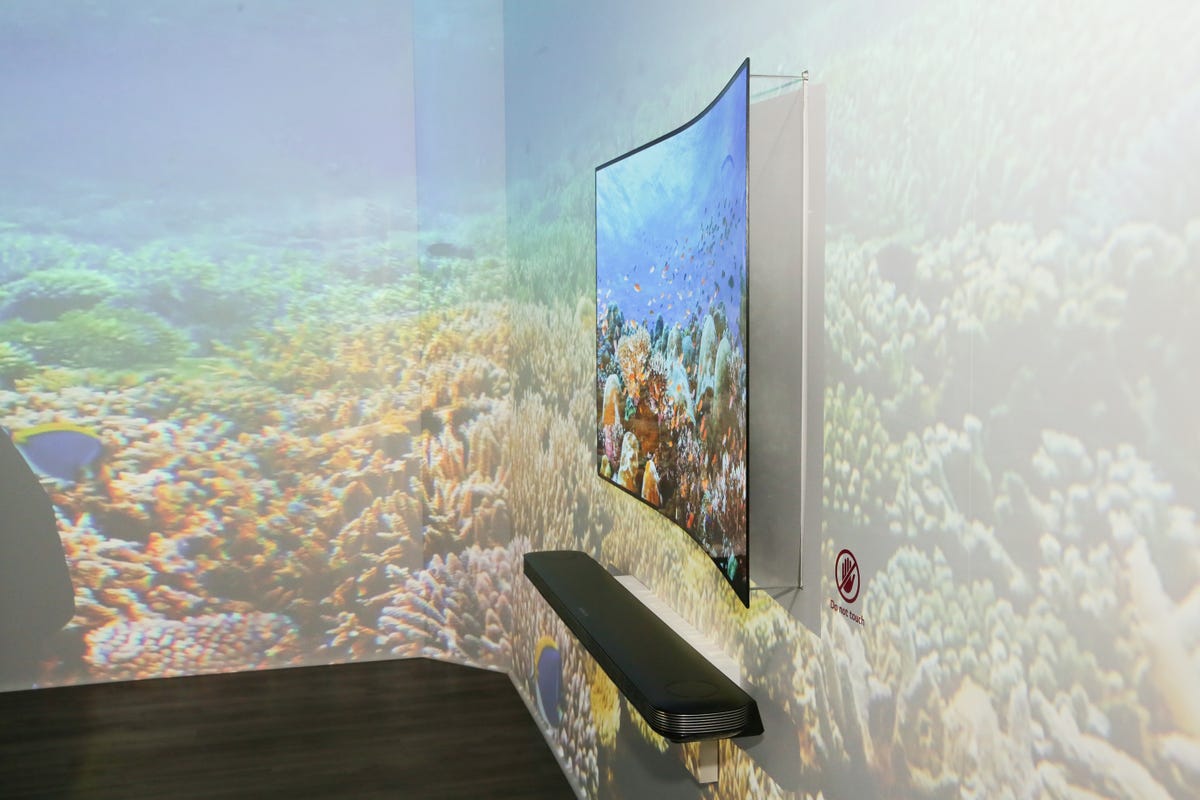 Why You Can Trust CNET
Why You Can Trust CNET 12 big-screen 4K TVs you wish you could afford
You can some great deals on big-screen TVs these days. These aren't those TVs.

LG W7 OLED
The all-new W7 OLED is like no TV you've ever seen. It can't stand by itself on legs or a pedestal. Instead, it requires a wall. And when attached to that wall, it protrudes no further than a couple of coins stacked together: just 3.85 mm. That's 0.15 inch, so thin you'd never notice it from the side.
LG will begin shipping the 65-inch W7 in March for $8,000 (roughly £6,580, AU$10,895). It will also be available in a 77-inch size, with pricing and availability to be determined. For reference LG's current, relatively thicker 77-inch OLED costs $20,000 (roughly £16,225, AU$27,515).
LG 77G6 Signature OLED
LG's most expensive 2016 TV, the G6 series, differentiates itself not with a better picture than less expensive OLEDs, but with sleeker styling. It's part of LG's "Signature" product lineup, which also includes a few high-end appliances. The 65-inch model can be had for $6,000, but the 77-incher comes in at a whopping $20,000 (roughly £16,225, AU$27,515).
Samsung QN88Q9F (88 inches, $20,000)
Part of its new line of high-end Quantum dot LED (QLED) TVs that are designed to compete with OLED models from LG and Sony, the 88-inch QN88Q9F is the largest QLED TV you can get from Samsung. It can be yours for $20,000 (roughly £16,225, AU$27,515).
Sony VPL-VZ1000ES 4K short-throw projector (100-inch, $25,000)
Sony's VPL-VZ1000ES isn't exactly a TV, but it comes close enough. It's a short-throw projector, meaning it can sit within inches of the wall and still project a huge image (you can project up to 120 inches or more). It can blend seamlessly into a cabinet, and the whole system can disappear entirely if you spring for a motorized screen. Sorry, that isn't included. (The $25,000 US price is approximately equal to £20,600 or AU$33,100.)
Sony XBR-100Z9D (100-inch, $60,000)
According to our resident video guru, Sony's latest high-end LED backlit LCD TVs could actually outperform the current kings of picture quality, LG's OLEDs. If nothing else, they're certainly brighter.The price of entry for the 65-inch size is $5,500 in the US, £4,000 in the UK (US price translates to about AU$7,300), where it's called the ZD9. The Z series also includes a 75-inch model ($9,000 or £7,000, or about AU$11,900) and a crazy 100-inch model that costs $60,000 or £60,000 (approximately AU$79,400).
Vizio R120-B3 (120-inch, $130,000)
Vizio is known for TVs that provide excellent value -- you could call it the Camry of televisions -- so the price bracket of the Reference series is a departure of epic proportions. The 120-inch version will set you back $130,000 (about £107,000 or AU$172,000) while its 65-inch sibling costs a cool $5,999 (about £4,950 or AU$7,950).
LeEco uMax85 (85-inch, $5,500)
TV makers with big names in China, like TCL and Hisense, are coming to the US market to challenge the dominance of Samsung, LG and Vizio. And the latest, LeEco, actually bought Vizio earlier this year.
Now owned by Vizio, LeEco, a well-known Chinese brand, has launched TVs under its own name and packed in some high-end technology at aggressive prices.
The most remarkable is an 85-inch monster called the uMax85, which costs a cool $5,500 (about £4,500 or AU$7,300). That's a huge TV and a lot of money, but for perspective, like-sized sets from Samsung and Sony cost $3,000 more, and don't feature the kind of high-end picture enhancements used by LeEco.
JVC DLA-RS4500 (4K projector, $35,000)
JVC makes some outstanding projectors and its DLA-RS4500 4K projector is the cream of the crop, selling for a mere $35,000. (That's about £28,000 or AU$46,300.)
Sony 65-inch XBR-65A1E OLED (65-inch, for $6,500)
From Editor David Katzmaier:
In 2017, Sony enters the OLED fray. The new A1E series ships in April and include the 55-inch XBR-55A1E for $5,000 (about £4,100 and AU$6,600) and the 65-inch XBR-65A1E for $6,500 (about £5,350 and AU$8,600). There will also be a 77-inch size, but pricing and availability were not disclosed.
Those prices are significantly higher than what LG is charging for its 2017 OLED TVs.
To help separate itself from the LG models, the Sony A1E boasts a new audio technology. The screen of the TV itself acts as a speaker to produce sound, so the audio emanates from the picture itself. It eliminates speakers around or behind the TV for what Sony is calling a standless form factor.
LG OLED65C7P OLED TV (65-inch, $4,500)
The C7 series is the least expensive member of LG's 2017 OLED TV lineup. But that doesn't mean they're cheap. The 55-inch size costs $3,500, while the 65-inch size costs $4,500. (That's about £2,900 and AU$4,600 and £3,700 and AU$6,000, respectively.)
Those prices are significantly higher than what LG is charging for its cheapest 2016 models, the B6 series, which we called the best-performing TV we've ever tested. They're also higher than what Samsung and Sony charge for some of their higher-end 2017 LCD TVs.
Sony VPL-VW675ES
We've kept out projector picks to native 4K models because they're pretty scarce -- and rather expensive. This Sony VPL-VW675ES is a great projector but it'll set you back $15,000 (about £12,400 and AU$20,000). And that doesn't include the screen, which can easily add another $5,000 (£4,100 and AU$6,600) to the cost.
Bang & Olufsen Beovision Avant (85 inches, $20,500)
What would a luxury product roundup be without something from Bang & Olufsen? Its Beovision Avant, which has a motorized stand and built-in sound bar, has been out for a while and seemingly discontinued, but you can still pick up a floor sample of the 85-inch model for $20,000 on eBay (roughly £16,225, AU$27,515).

